
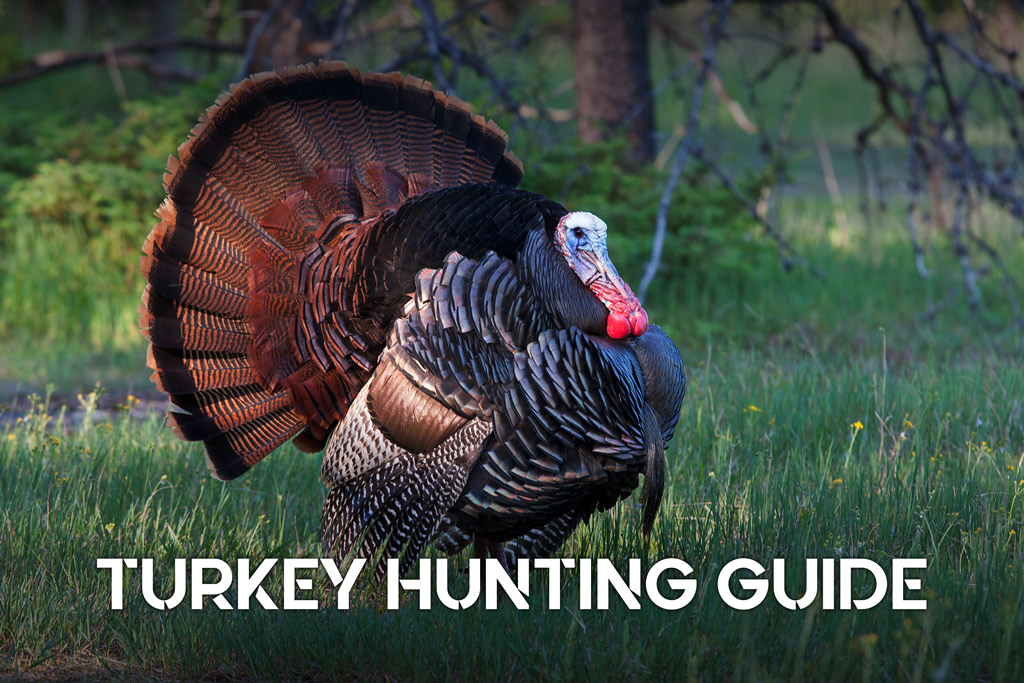
Every year by mid-winter I find myself longing for the crisp, cool morning of a seasonal turkey hunt. The sounds and smells of being in the woods scouting for and hunting turkeys after a long winter is exactly what makes me love it so much. I wish I’d had a turkey hunting guide to point me in the right direction when I started. Instead, I learned from making mistakes that I’ll help you to avoid in the article below.
I’ll admit, first and foremost, I’m an avid deer hunter. Turkey hunting was something I decided to try out of sheer boredom. I was bow hunting deer one season on a small farm in a remote area of New Hampshire. I hadn’t seen a deer in the area all weekend and I was thinking of packing up and leaving camp early.
Call Of The Wild (Turkey)
Right around sunset, a rafter of turkeys appeared in the field just below me. There must have been 15-20 of them, with two or three good-sized Toms. The rafter crossed the field and flew up into nearby maple trees. I knew the racket they were making would put any deer in the area on high alert, so I decided to watch their movements and wait.
I’d seen turkeys countless times prior to this, so I’m not sure what sparked my interest in this particular rafter of wild birds. The next morning I put down my bow and grabbed my shotgun, I loaded 3-inch 12 gauge shells for the hunt. I headed back to the field and despite my mistakes, I miraculously bagged a bird on my very first turkey hunt.
All these years later and I’m still hooked on turkey hunting, I can’t imagine going a season without it. Along the way, I’ve gained a lot of valuable experience and made countless memories. I hope to impart some of my knowledge to you in this article so you can bag a bird quickly and avoid common mistakes.
Turkey Hunting Guide
This will be a beginner’s turkey hunting guide to discuss several key points:
This article will not answer all your questions about turkey hunting, but hopefully, it will serve as a guideline. I can give you the basic tools, but it’s up to you to put in the time and dedication to perfect the craft.
Turkey Identification
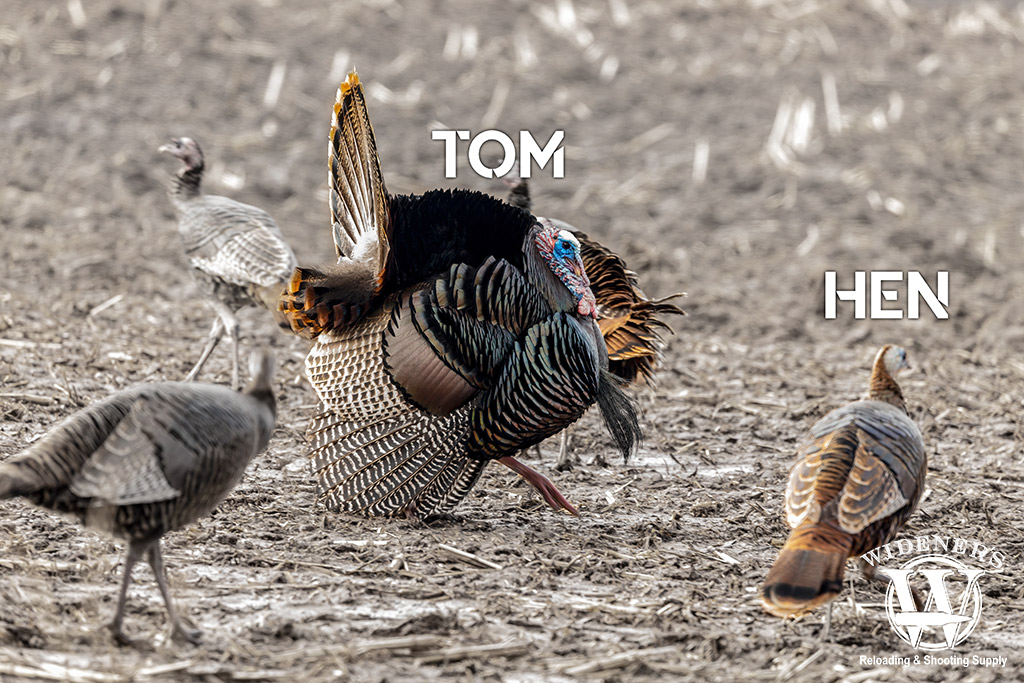
A Tom is a mature male turkey, a Jake is a juvenile male turkey, a Hen is a female turkey.
Before we get into how to hunt turkeys, let’s make sure you can identify and locate these bad larries.
There are three basic turkeys you will see, Tom- the adult male, Jakes- younger males, and Hens- the females. Each of the sexes has different characteristics, which you’ll need to know before you go hunting.
Tom
The Tom Turkey is the most iconic of the Turkeys.
The Tom is larger in size than Jakes and Hens. They have dark, almost black feathers on their breast that shine. On their breast is a long, coarse hair-like beard. Their heads are red, white, and blue. Patriotic right? Probably why Ben Franklin wanted this to be the Nation’s bird. When displaying, Toms will puff up and fan out their tail.
Jake
Jakes will look very similar to Tom turkeys. However, they are smaller and have little to no white on the head. They will also have a beard, but usually only 3 inches or so. Their tail feathers may also be uneven. Jakes act just like Toms and make for great decoys.
Hens
The Hen is going to be smaller than a Tom, but still a decent size. A Hen will have a long neck and no beard. The Hen’s entire body will be a shade of brown, except its wingtips which will have some light brown or copperish-looking colors.
Turkey Hunting Habitat
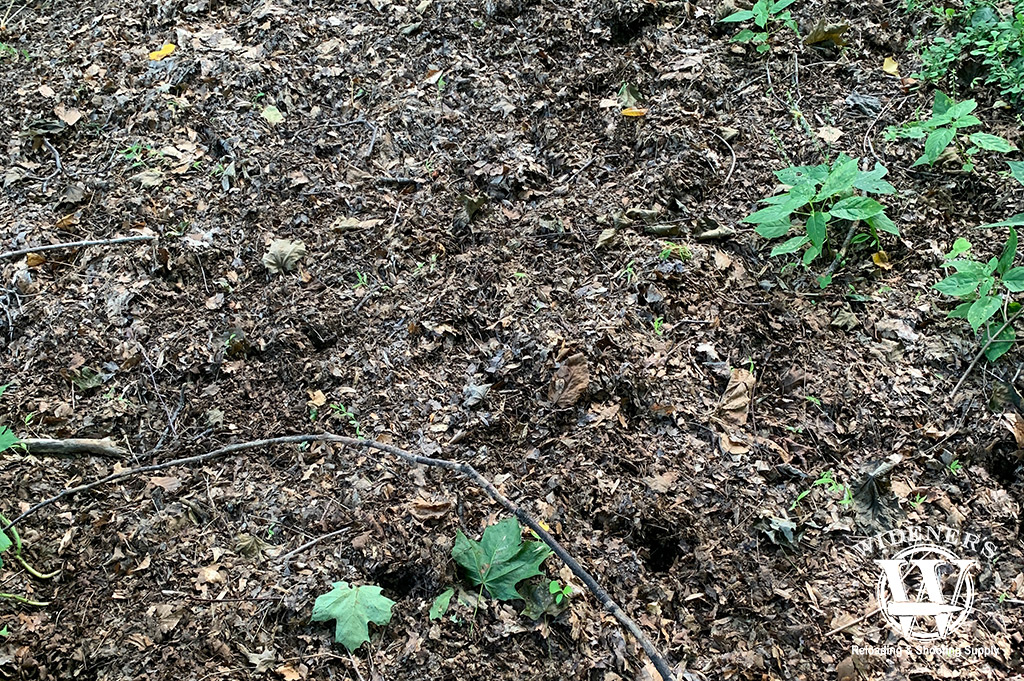
Be sure to look for signs of rooting in areas with hardwood trees where turkeys like to roost.
Turkeys prefer to be in an area that provides hardwood trees for cover and roosting, but like to have access to fields and open spaces to forage for food.
Roosting
Turkeys will roost in large trees, such as oaks, maples, or pines. They will try to get as high up as possible and stay there at night to avoid predators.
“Try to locate the turkey’s roosting spot and set up nearby, when the turkey’s come down in the morning you should be able to get a shot.”
Turkey Diet
Turkeys will consume a variety of bugs, snails, slugs, berries, wildflowers, grasses, and can destroy your small vegetable garden.
Preparing For Your Hunt
Now that you have some basic knowledge about turkeys, let’s start discussing some gear and tools you will need to get the job done.
Now, if this is your first turkey hunt don’t go running off buying all this stuff. My first two seasons of turkey hunting, I used a combination of my waterfowl and deer hunting gear. The very first turkey I got, was with my waterfowl 12GA and #2 steel shot. So, don’t think you need to go out and spend $1,000 on turkey gear to go hunting.
Turkey HuntingWeapons: Shotgun Or Bow
There are two weapons that are primarily used for turkey hunts, shotguns, and bows. I use both and like both. When I say bows, I mean traditional, compound, or crossbow, whatever you choose is fine.
Shotguns
Really, there are two choices nowadays, the 12GA and 20GA. Personally, I like a 12GA shotgun chambered for 3-inch shells. However, it is all about shot placement, so you can get a turkey with a 20GA. With a 20GA you may just need to let the bird get a little closer.
Choke
When turkey hunting you will want a tight pattern. A lot of people like full chokes, because they have a tight pattern and will allow you to range out.
I personally like chokes specifically designed for turkey hunting. These are suped-up full chokes that keep your patterns tight.
Whatever choke you use you will want to pattern your gun (see below).
Turkey Hunting Ammunition
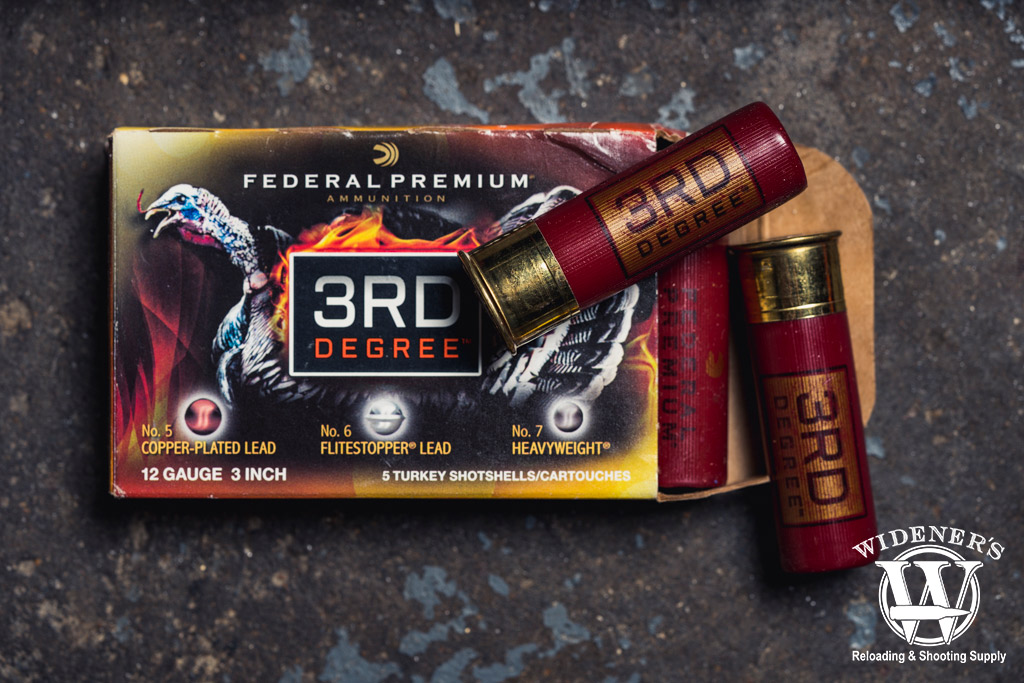
There’s a wide variety of turkey loads with different flight patterns available on the market.
Regular #2-5 birdshot will work. The smaller the shot, the closer you will want to get to the bird. Remember it is all about shot placement, which we will discuss below.
I like to use shells specifically made for turkey hunting. They are made from tungsten and are #4 shot. These have a good range and a great pattern. They are expensive, but I only use 4 or 5 shells per year, so one box will last a while.
Patterning Your Gun
First, determine at what range you feel comfortable shooting the bird and what is a realistic shot. On average this will be in the 20-40 yard range. You can take a look at different 12-gauge ammo shot patterns at this link.
Now take your shotgun, choke, and ammunition, and shoot at a target that mimics a turkey’s head. You are looking to get 70% of your pellets into the turkey’s head and neck area. If you can do that, then you are good to go.
Archery Options
Whatever bow you use for big game hunting will be more than enough for turkey.
With archery, you need to pay more attention to the arrowhead. You can use fixed blades, mechanicals, or anything else you fancy.
I love wild turkey meat, so I like to decapitate the bird with a guillotine broadhead. This prevents damaging the precious meat.
Turkey Hunting: Shot Placement
Shot placement is more important than the type of weapon or ammo you are using.
With a shotgun, you will want to hit the turkey in the neck and head area. This will quickly and humanely kill the bird. It will also preserve all edible meat.
With archery, you can try to decapitate the bird, as I discussed above or hit the vital organs. The vital organs are towards the front of the bird, a few inches behind where the beard is. The organs are a small target and will damage some meat, but many hunters prefer this method.
Camouflage
Turkeys actually have amazing eyesight. They can spot any movement or irregularities in their environment within seconds. This is why camo is important.
Basically, your entire body, hands, and even face should be covered. Try to get a good camo pattern that matches your area. Also, I try to get all the same camo pattern, so my legs, body, and face all match.
Turkey Vest
If you spend any amount of time hunting you will probably want to consider getting a turkey vest. It is a vest with pads on the back, which cushions you when leaning against a tree, and usually has a seat pad.
There are special pockets on the vest for easy access to calls, shells, binos, water, and whatever else you like to carry turkey hunting.
My vest was fairly cheap, I think $50 or so, and just makes turkey hunting comfortable. I will also use it for deer hunting, if I am not taking a stand.
Turkey Calls
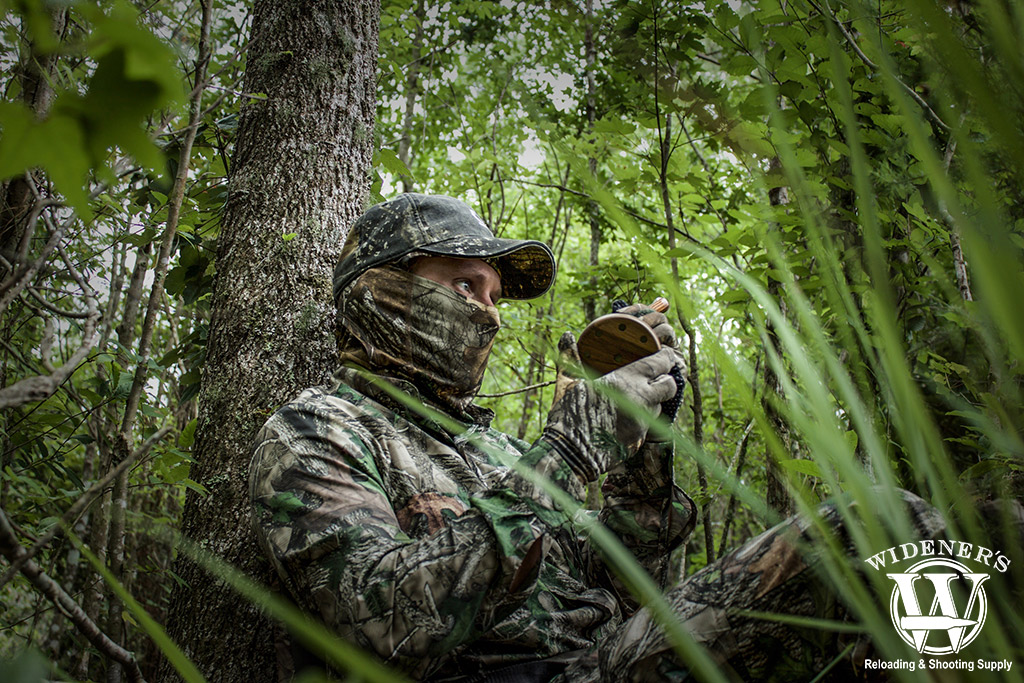
A friction call is usually the easiest bird-call option for new hunters to learn how to use.
One of the most exciting things about turkey hunting is being able to interact with the birds. You can make a clucking call and wait for a Tom to gobble back, or make gobbles and hope a Tom charges in, both are fun and effective.
There are three basic calls
- Box
- Friction
- Diaphragm (mouth call)
All three are good and all three work well. If you are going to bow hunt you’ll want to look at the diaphragm. If you are using a gun then all three are in play.
I personally like a box call. However, if you hunt up north, in New England, Spring and Fall can be chilly. It can be difficult operating a friction call with bulky gloves. However, I’ve never had that issue with a box call. Diaphragms are really good, but it takes time and practice.
Some good calls to learn:
- Clucks
- Putts
- Purring
- Gobbling
- Yelps
Each call serves a purpose. Start with a basic yelp and work your way up to more advanced calls.
Don’t be the hunter that watches a YouTube clip and all of a sudden thinks they are a master caller and overdo it. Less is more when calling in turkeys. I have been turkey hunting for over a decade and call in most of my birds with a simple cluck or yelp. Don’t try to get fancy.
Using Turkey Decoys
Turkey decoys are a great addition to any turkey hunter’s arsenal. There are all sorts of ways to set up and use decoys.
I like to set out a Jake with a couple of Hens. Then make a few calls. Toms will come sprinting in thinking Jake is getting all the action.
My buddy only sets up Hens and has good luck.
Decoys can range from cheap to pricey, but make sure if you go down this route you buy decoys that are decent. A quality decoy will last for years, so splurge a little if you can.
Turkey Hunting: Quick Start Guide
Now, we know where to find the birds and what gear we will be using. Let’s start getting ready to get a bird.
Scouting
Scouting is the single most important skill when trying to hunt any species, especially turkeys.
- Step One
I will check an area I want to hunt on Google Earth. I look for an area with a good mixture of trees and fields. In New England, I often look for abandoned apple orchards (this is a dual purpose because I am an avid upland bird hunter).
- Step Two
Once I find an area that looks good, I try to get boots on the ground to check it in person. However, I work full-time and have kids, so this isn’t always accomplished.
“If I skip step two, my first turkey hunt of the year will double as a scouting mission, I end up doing a lot more calls and hiking.”
- Step Three
Look for sign. Look for tracks or drags on the ground. Additionally, look for wingtips that fell out. You can usually tell where a turkey has been.
I will also try to head into the woods in March or April, when there is some snow on the ground and I can look for prints.
- Step Four
Set up shop. Now it is time to look for a good spot to set up. I like to sit in the woods, right on the edge of an opening.
Concealment
Now that you have a good spot to set up shop, let’s talk about concealment. Some hunters like to use ground blinds. These are a great option if you plan on hunting the same area for a long period of time.
I think the most common is for hunters to set up with their back leaning against a tree. Then try to have a little bit of coverage in front of you to conceal movements, but not obstruct your view.
Field To Table
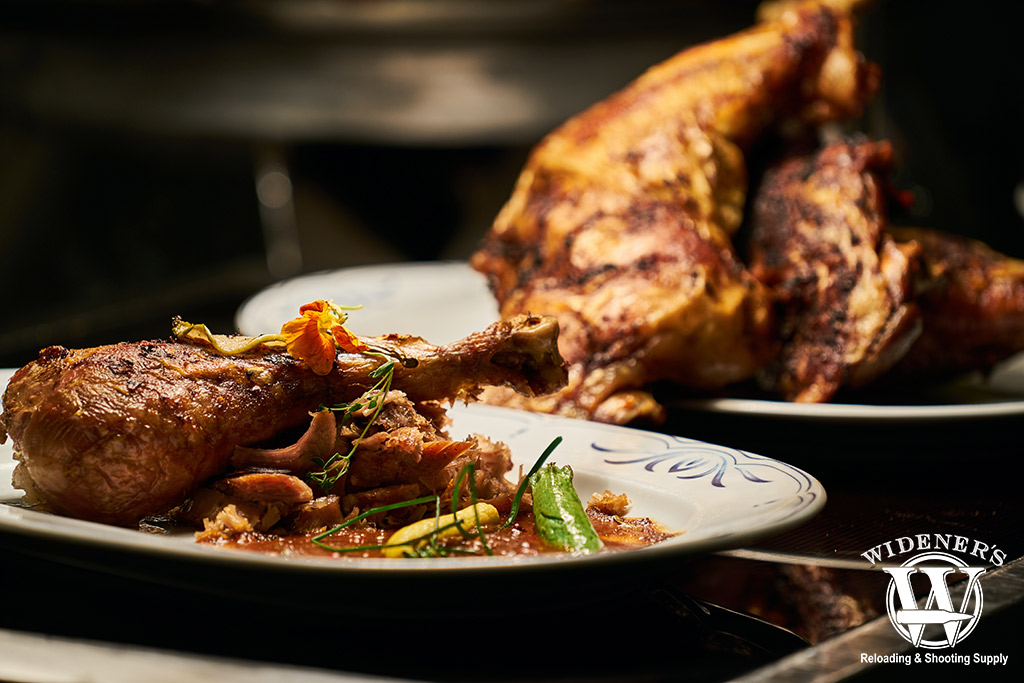
There’s no wrong way to cook a turkey, just be sure to brine your turkey before cooking it.
Now let’s assume you did everything right and bagged a bird. Let’s field dress it. First, remember many states require you to leave a sign of the sex on the bird. So you can keep the feet attached or check in the bird before you field dress it. That’s your call.
There are two basic methods. Your best bet is to YouTube them. But, these are breasting the bird or plucking it.
I used to only breast out my turkeys. Then I realized what a disservice I was doing to my birds. Now I pluck all my turkeys. It takes a little time and patience, but it is worth it. The skin will keep the bird moist during cooking.
Cooking Your Bird
Now that you’ve dressed your bird, let’s talk about cooking it. You can cook a wild turkey just like you would a store-bought turkey.
Something to consider is that these turkeys are wild, you may notice more dark meat and some say it’s a little tougher, I have never noticed a real difference. Either way, I recommend brining your turkey before cooking it.
Personally, I like to deep fry or smoke my turkey. I feel like the smoke enhances the natural flavors of the turkey. But, I’ve found that when you deep fry it, people who are hesitant about game meat are more apt to give it a shot.
Final Turkey Call

Learn by doing, don’t worry about making mistakes, experience on the ground equals success during turkey season.
As I mentioned this is a basic outline to get you started in turkey hunting. It’s not possible for me to list everything you need to know in a single article. However, this guide should be a good starting point for the novice turkey hunter. Be sure to make a list and check it twice before you head out the door on your first hunt.
Nothing will beat the experience of boots on the ground during turkey season. I got lucky bagging a turkey on my first hunt, but you may need to spend a few weeks looking for the right signs, practicing calls (that annoy your wife and kids), and getting your camo/concealment perfect before you land your first bird.


